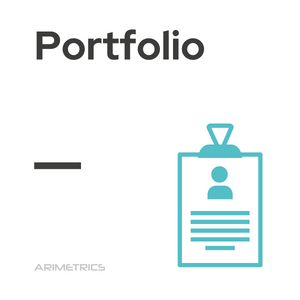 Definition:
Definition:
The term portfolio, originally, it refers to a briefcase or suitcase for carrying documents. However, in the professional context, a portfolio is a collection of work done by a person or company over the course of their career. It can belong to either an individual creative, compiling their commissions, or to a business, showcasing their projects and achievements.
In the workplace, the concept of portfolio has expanded to include the presentation of work, especially in graphic sectors such as architecture, design, web development and advertising. In the digital marketing sector, having a digital portfolio is essential for designers, copywriters, strategists and other specialists, serving as a professional cover letter.
What is a portfolio for?
A portfolio is an essential tool for presenting individual or business work in an organized and accessible manner. Its primary purpose is to allow future employers, clients or collaborators to quickly assess a person’s or business’ capabilities and accomplishments. The following are some of the specific functions of a portfolio:
- Showcase skills and experience: A portfolio acts as a showcase of an individual’s professional skills and experience. By including concrete examples of your work, you can demonstrate competence in specific areas and highlight strengths.
- Attract clients and employers: By providing a clear vision of what can be achieved, a well-crafted portfolio can capture the attention of potential clients and employers, facilitating new job or business opportunities.
- Build credibility and trust: By presenting past work and testimonials from satisfied clients, a portfolio helps build credibility and trust. This is especially important in convincing new clients that a person or business is the right choice for their needs.
- Facilitate self-assessment: Maintaining a portfolio allows one to reflect on one’s own professional development. By reviewing past work, you can identify areas for improvement and set goals for the future.
- Differentiate yourself from the competition: In a competitive market, a unique and well-designed portfolio can set a professional apart from others. By highlighting a personal style and unique approach, you can attract clients who value distinctive features.
How to create a portfolio
A portfolio is essential for showcasing professional performance and skills, as well as for capturing the attention of potential clients or future employers. Here are some key steps to creating an effective one:
- Gather data and materials: It is important to collect all relevant material, including outstanding projects, achievements and career details. Content should be aligned with the target market and potential recruiters.
- Organize the information: Information should be structured logically and coherently. It should be easy to navigate and clearly convey capabilities and experiences.
- Presenting the portfolio: It is important to decide whether the portfolio will be digital, physical or both. Each format has its advantages, so it is important to choose the one that best suits your needs and target audience.
Tips for creating a digital portfolio
Creating an effective digital portfolio is essential to standing out in today’s professional environment. Here are some key tips for developing a digital portfolio that captures the attention of potential clients and employers:
- Choose an optimized platform: It is advisable to use a platform with responsive design to ensure that the portfolio looks good on mobile devices, tablets and PCs.
- Simplicity and good design: Web and graphic design principles should be applied, leaving white space, using graphics that lighten the content and maintaining a uniform color palette.
- Incorporate a welcome video: Considering including an introductory video can build trust and humanize the personal brand.
- Make regular updates: It is advisable to update the portfolio on a monthly or quarterly basis, removing obsolete content and adding new projects.
- Optimize for SEO: Ensure that the portfolio is optimized for search engines to improve its visibility.
- Add testimonials and reviews: Including positive experiences from previous clients or employers can build trust with future employees or clients.
